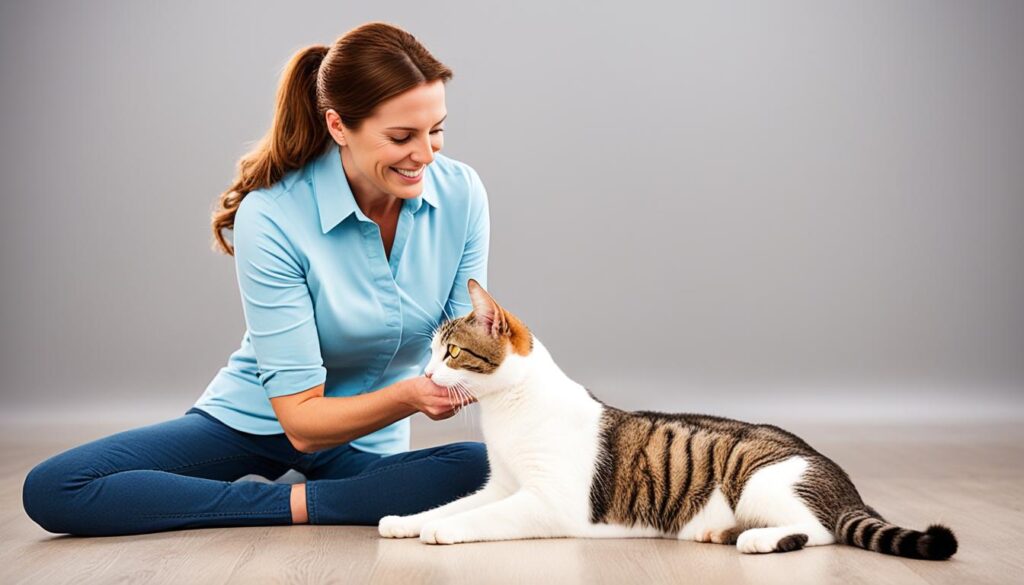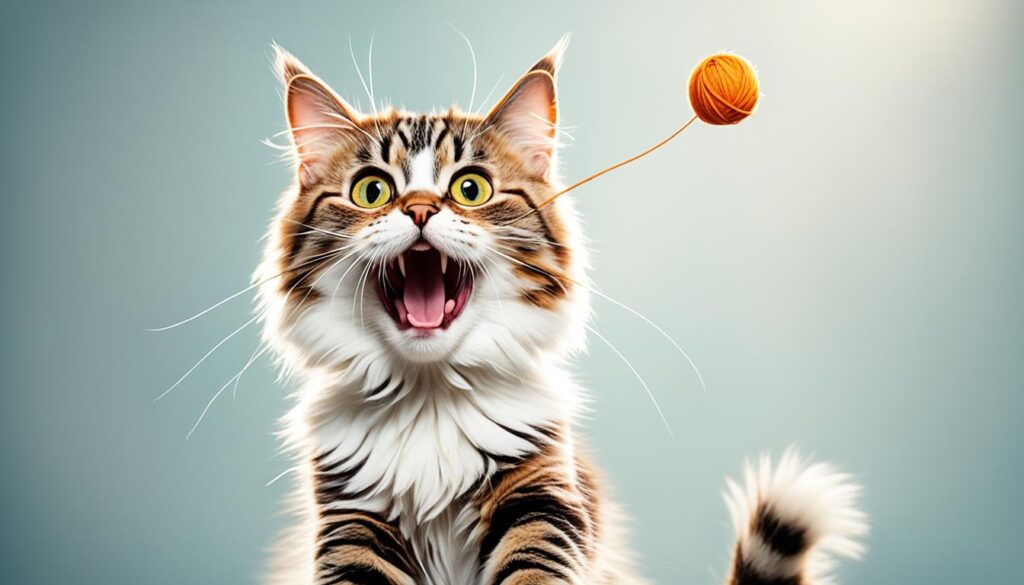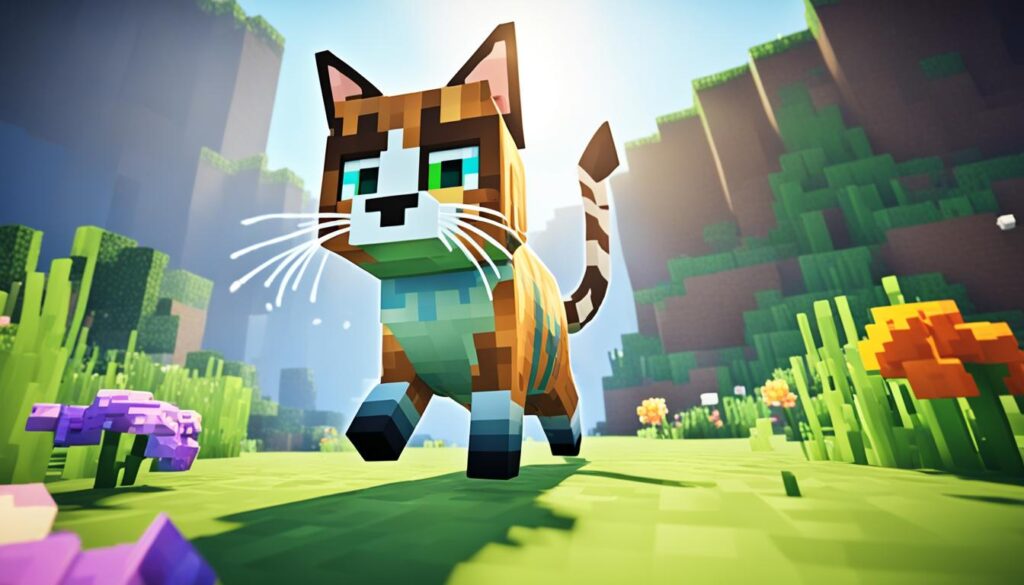Imagine this: you come home after a long, exhausting day. The weight of the world lingers on your shoulders as you open the door to find your furry friend waiting for you. Instantly, the stress melts away as they rub against your legs, purring softly. This simple act of affection brings warmth to your heart and a smile to your face.
Cats have a unique ability to bring comfort and solace to our lives. Whether you’re a long-time cat owner or considering getting a feline companion, knowing how to properly pet a cat is essential for building a strong and meaningful bond.
In this article, we’ll explore the art of cat petting and share valuable tips to help you create a harmonious and enjoyable experience for both you and your beloved cat. From understanding their behavior and body language to identifying their preferred petting zones, we’ll guide you on this journey of affectionate connection. So let’s dive in and discover the secrets of petting a cat with love and confidence.
Key Takeaways:
- Proper petting is crucial for building a strong bond with your cat.
- Understanding cat behavior and body language is essential for effective communication.
- Creating a safe and comfortable environment promotes relaxation and opennes
- Petting should be approached with patience, respect, and a gentle touch.
- Identifying your cat’s preferred petting zones ensures maximum enjoyment.
Understanding Cat Behavior and Body Language
Before delving into the art of cat petting, it’s crucial to grasp how cats communicate through their behavior and body language. Understanding these feline cues will enable you to decipher your cat’s signals and respond appropriately, fostering a deeper connection with your furry friend.
Decoding Cat Behavior
Cats exhibit a wide range of behaviors to express their emotions and needs. By observing their actions, you can gain valuable insights into their state of mind. Here are some common cat behaviors and their meanings:
| Behavior | Meaning |
|---|---|
| Purring | Sign of contentment and relaxation |
| Meowing | Indicates various needs like hunger, attention, or discomfort |
| Scratching | Natural way to mark territory and sharpen claws |
| Hissing or Growling | Sign of fear or aggression |
| Kneading | Behavior from kittenhood, representing comfort and contentment |
These behaviors provide valuable clues about your cat’s emotions and intentions. It’s essential to pay attention to their body language to further understand their needs and desires.
Interpreting Cat Body Language
Cat body language is a complex system of cues and signals that convey their emotions and intentions. By observing their posture, facial expressions, and tail movements, you can gain insights into what your cat is trying to communicate. Here are a few key body language cues and their meanings:
- Ears pointed forward: Alert and attentive
- Flattened ears: Fear or aggression
- Tail held high: Confidence and friendliness
- Puffed-up tail: Fear or agitation
- Dilated pupils: Excitement, fear, or aggression
By understanding these cat body language cues, you can appropriately respond to your cat’s moods and create a comfortable environment for them.
Now that you have a foundation in understanding cat behavior and body language, you are ready to dive into the techniques of petting in the next section. Remember, by paying attention to your cat’s signals, you can build a stronger bond and provide the affection and care they need.
Creating a Safe and Comfortable Environment
When it comes to cat care, creating a safe and comfortable environment is essential for your feline friend to feel relaxed and open to affectionate gestures. By providing the right conditions, you can ensure that your cat is happy, secure, and more receptive to your love and attention.
Here are some important aspects to consider:
- Provide a quiet space: Cats appreciate a peaceful environment where they can retreat to when they need some alone time. Set up a cozy corner or a separate room with a comfortable bed and toys for your cat to unwind and recharge.
- Ensure proper litter box placement: Placing the litter box in a quiet and easily accessible area will help your cat feel at ease while taking care of their toileting needs. Avoid high-traffic areas or noisy spots that may startle or disturb them.
- Offer vertical spaces: Cats love to climb and explore their surroundings. Install cat trees, perches, or shelving units to create vertical spaces where they can perch, observe their territory, and feel a sense of security.
- Keep a consistent routine: Cats thrive on routine and predictability. Establish a regular schedule for feeding, playtime, and sleep to provide your cat with a sense of stability and security.
- Eliminate hazards: Ensure that your home is free from potential dangers for your cat. Secure loose cords, keep toxic plants out of reach, and store cleaning products and medications safely away from your curious feline.
By focusing on these aspects of cat care, you can create an environment that promotes relaxation, trust, and happiness for your beloved pet.
“A cat will be your friend, but never your slave.”
– Theophile Gautier
| Creating a Safe and Comfortable Environment for Your Cat | |
|---|---|
| Aspect | Importance |
| Providing a quiet space | Allows your cat to relax and recharge. |
| Ensuring proper litter box placement | Helps prevent stress and promotes good litter box habits. |
| Offering vertical spaces | Gives your cat a sense of security and a place to observe their surroundings. |
| Keeping a consistent routine | Provides stability and a sense of security for your cat. |
| Eliminating hazards | Prevents accidents and keeps your cat safe from potential dangers. |
Approaching a Cat with Patience and Respect
When it comes to cat companionship, approaching your feline friend with patience and respect is key. Cats are sensitive creatures who appreciate a gentle and understanding approach. By following these tips, you can build trust and strengthen the bond with your cat:
- Give them space: Cats need their own personal space and may feel threatened if approached too quickly or aggressively. Allow them to come to you on their terms.
- Use slow movements: Quick movements can startle cats. Instead, move slowly and calmly to make them feel more comfortable in your presence.
- Avoid direct eye contact: Eye contact can be perceived as a threat by cats. Instead, blink softly or glance away to show that you mean no harm.
- Offer a hand for sniffing: Extend your hand for your cat to sniff and get familiar with your scent before attempting to pet them.
- Let them guide the interaction: Pay attention to your cat’s body language and signals. If they show signs of discomfort or withdrawal, give them space and try again later.
Remember, building a strong bond with your cat takes time and patience. By approaching them with respect and understanding, you can create a safe and nurturing environment for your cat companionship to thrive.
Quote:
“Cats are independent, but they still need companionship and love from their humans. By approaching them with patience and respect, you can develop a deep and meaningful bond.” – Dr. Sarah Lewis, Feline Behavior Specialist
Comparing Approaches
| Approach | Outcome |
|---|---|
| Rushing towards the cat | Causes fear and potential aggression |
| Slow, calm approach | Builds trust and encourages positive interaction |
| Staring directly into the cat’s eyes | May be perceived as a threat |
| Gentle blinking and looking away | Shows non-threatening intentions and builds comfort |
| Forceful physical contact | Can result in scratches or bites |
| Allowing the cat to approach you | Respects their boundaries and encourages trust |
Identifying Preferred Petting Zones
When it comes to petting cats, one size does not fit all. Each feline friend has their own unique preferences and sensitive spots. By understanding different cat petting techniques and identifying your cat’s preferred petting zones, you can ensure a purrfectly enjoyable experience for both of you.
Understanding Cat Body Language
Cats communicate their comfort and enjoyment through their body language. It’s important to pay attention to their cues to determine the best way to pet them. Signs of enjoyment may include relaxed body posture, slow blinking, and a softly purring kitty. On the other hand, signs of discomfort may include flattened ears, a twitching tail, or attempts to move away.
Remember, always respect your cat’s boundaries and never force them to be petted.
Different Petting Techniques
Experimenting with various petting techniques can help you find what your cat loves the most. While some cats enjoy gentle strokes from head to tail, others prefer focused petting on specific areas like their chin, cheeks, or base of the tail. Observe your cat’s reaction to each technique and adapt accordingly.
Here are some commonly used cat petting techniques:
- Soft strokes from the head to the tail, following the direction of their fur
- Gentle chin scratches
- Slow, circular motions on their cheeks or behind the ears
- Lightly massaging the base of their tail
Remember, always start with a gentle approach and read your cat’s signals to determine their comfort level.
Preferred Petting Zones
While cats have different preferences, there are some common petting zones that many cats enjoy. These areas are generally considered safe and pleasurable for most feline companions:
| Preferred Petting Zones | Description |
|---|---|
| The head | Most cats appreciate gentle strokes on their head, especially around their ears and under their chin. |
| The cheeks | Many cats enjoy light, circular motions on their cheeks. This area may elicit content purring. |
| The neck and shoulders | Gentle petting along the neck and shoulders can be soothing for cats, creating a sense of security. |
| The base of the tail | Some cats enjoy being petted at the base of their tail, but it’s important to be gentle and observe their response. |
Remember, these are general guidelines, and each cat is unique. It’s essential to pay attention to your cat’s individual preferences and adjust your petting technique accordingly.

With these insights into cat petting techniques and preferred zones, you’ll be well-equipped to create a truly enjoyable and bonding experience with your furry companion.
Observing Signs of Enjoyment and Discomfort
Cats have their unique ways of expressing how they feel during petting. Understanding their body language is crucial to ensure a pleasurable experience for both you and your feline friend. Here, we’ll explore the subtle signals that cats use to convey their level of comfort and provide you with the knowledge to interpret them accurately.
Recognizing Signs of Enjoyment
When a cat is enjoying your touch, they may exhibit the following signs of contentment:
- Purring softly
- Relaxed body posture
- Slow blinking or half-closed eyes
- Gently kneading with their paws
- Exposed belly
These indicators typically suggest that your cat is enjoying the petting and feels comfortable in your presence.
Identifying Signs of Discomfort
On the other hand, cats may display signs of discomfort or overstimulation during petting. It’s essential to be attentive and respond appropriately when you notice these signals:
- Tail flicking or swishing vigorously
- Flattened ears or ears pinned back
- Dilated pupils
- Restlessness or attempts to move away
- Agitated meowing or hissing
These signs indicate that your cat may be feeling uneasy or overwhelmed. It’s crucial to respect their boundaries and adjust your petting technique or give them space when necessary.
| Signs of Enjoyment | Signs of Discomfort |
|---|---|
| Purring softly | Tail flicking or swishing vigorously |
| Relaxed body posture | Flattened ears or ears pinned back |
| Slow blinking or half-closed eyes | Dilated pupils |
| Gently kneading with their paws | Restlessness or attempts to move away |
| Exposed belly | Agitated meowing or hissing |
By recognizing and responding to your cat’s body language, you can ensure that the petting experience is enjoyable and stress-free for both of you.
Petting Techniques for Different Personalities
Just like humans, cats have their own unique personalities. Some cats may be more affectionate and enjoy constant attention, while others may be more independent and prefer occasional petting sessions. Understanding your cat’s personality and tailoring your petting technique to suit their individual preferences and temperament is key to building a strong bond.
Here are some cat petting tips to consider:
- Observe and respect boundaries: Pay attention to your cat’s body language and cues. If they show signs of discomfort, such as flattened ears, flicking tail, or attempts to move away, it’s best to give them space and avoid petting at that moment. Respect their boundaries to maintain their trust and comfort.
- Start with gentle strokes: Begin petting your cat with slow, gentle strokes using your fingertips. This allows them to get accustomed to your touch and assess their level of comfort.
- Focus on their preferences: Cats have certain areas they enjoy being petted, such as the chin, cheeks, and base of the tail. Experiment with different strokes and areas to find what your cat likes best. Keep in mind that not all cats enjoy being touched on their belly or back.
- Use your voice: Cats respond positively to a soothing and reassuring voice. Talk to your cat softly while petting them to create a calming atmosphere.
- Try different techniques: In addition to gentle strokes, you can also experiment with other petting techniques, such as kneading or massaging their back, scratching their chin, or lightly tugging their ears. Pay attention to their reactions and adjust accordingly.
Remember, every cat is unique, and what works for one may not work for another. Take the time to understand your cat’s preferences and modify your petting techniques accordingly. Building a strong bond with your feline friend through tailored and appropriate petting will contribute to a happy and fulfilling relationship.
Building Trust and Strengthening the Bond
Petting is a wonderful opportunity to strengthen the bond between you and your cat. By using petting as a tool, you can build trust and deepen your relationship in a meaningful way.
One of the key elements in bonding with a cat is to respect their boundaries. Just like humans, cats have different preferences when it comes to physical contact. Some cats may enjoy long strokes along their back, while others may prefer gentle chin scratches or head rubs. Take the time to observe and understand your cat’s cues, and adjust your petting technique to suit their individual needs.
During petting sessions, ensure that your cat remains comfortable and calm. Approach them in a relaxed manner, using slow and gentle movements. Avoid sudden or rough gestures that may startle or scare your cat. Remember, trust is built over time, so be patient and allow your cat to approach you on their own terms.
Pro Tip: If your cat shows signs of discomfort during petting, such as flattened ears, swishing tail, or attempts to move away, give them space and allow them to retreat. This will help them feel safe and prevent any negative associations with the petting experience.
Creating a calm environment can also contribute to strengthening the bond with your cat. Find a quiet and peaceful space where you can engage in petting sessions without distractions. This will allow you and your cat to focus solely on each other, fostering a deeper connection.
Remember, bonding with a cat is a gradual process that requires patience, understanding, and respect. Celebrate the small moments of connection and find joy in each interaction. The more you invest in building a strong bond through petting, the greater the rewards in terms of love, trust, and companionship.
Building trust and strengthening the bond with your cat through petting creates a foundation of love and companionship that will last a lifetime.
Avoiding Overstimulation and Petting Etiquette
When it comes to petting a cat, there’s a fine balance between providing affection and avoiding overstimulation. Cats have different preferences and boundaries, so it’s important to understand proper petting etiquette to ensure a positive and enjoyable experience for both you and your furry friend.
Overstimulation can lead to negative reactions from cats. It’s crucial to pay attention to your cat’s body language and signals to avoid pushing their limits and causing discomfort. Signs of overstimulation can include twitching tail, flattened ears, dilated pupils, or a sudden change in behavior.
To pet a cat properly and prevent overstimulation, keep in mind the following guidelines:
- 1. Respect your cat’s personal space: Allow your cat to approach you for petting, rather than forcing your affection on them. This ensures that they feel comfortable and in control of the interaction.
- 2. Focus on areas they enjoy: Cats have specific areas they prefer to be petted. These often include the chin, cheeks, and the base of the tail. Gently stroke these areas and observe your cat’s response. If they lean in or purr, it’s a sign they’re enjoying the petting.
- 3. Avoid sensitive areas: Some cats are sensitive to being touched in certain areas, such as the stomach or tail. Respect their boundaries and refrain from petting these areas if your cat shows signs of discomfort or tries to move away.
- 4. Monitor your cat’s body language: Pay attention to your cat’s body language throughout the petting session. If they start to show signs of discomfort, such as tensing up or flicking their tail, it’s best to give them a break and provide space.
- 5. Keep petting sessions short and frequent: Cats often prefer shorter bursts of affection rather than prolonged petting. Aim for multiple short sessions throughout the day to prevent overstimulation and allow your cat to recharge.
“Cats are connoisseurs of comfort.”
– James Herriot
Remember, every cat is unique, and what works for one may not work for another. Take the time to understand your cat’s preferences and limits, and adjust your approach accordingly. By following proper petting etiquette and respecting your cat’s boundaries, you’ll build trust and create a harmonious bond with your feline companion.
Signs of Overstimulation in Cats
| Signs of Overstimulation | Meaning |
|---|---|
| Twitching tail | Sign of irritation or over-excitement |
| Flattened ears | Indicator of discomfort or aggression |
| Dilated pupils | Could mean fear, stress, or arousal |
| Sudden change in behavior | May include biting, scratching, or hissing |

Incorporating Petting into a Daily Routine
Your cat craves your affection and attention, and incorporating petting into your daily routine is a wonderful way to strengthen your bond and provide essential care. By making petting a regular part of your cat care routine, you can ensure a consistent connection and promote their overall well-being.
Here are some tips on how to make petting a daily habit:
- Set aside dedicated time: Find a time in your daily schedule to spend quality time with your cat. This can be in the morning before work, during your lunch break, or in the evening when you’re winding down.
- Create a cozy environment: Make sure the space where you’ll be petting your cat is comfortable and free from distractions. Set up a cozy bed or blanket for them to relax on.
- Use positive reinforcement: Reward your cat with treats or gentle praise during and after petting sessions to reinforce their positive behavior and create positive associations.
- Pay attention to their preferences: Every cat has different preferences when it comes to petting. Observe your cat’s body language and adjust your technique to cater to their individual needs and desires.
Quotes:
“Regular petting sessions provide more than just physical affection; they also promote emotional well-being and help your cat feel loved and secure.”
“Incorporating petting into your daily routine allows you to build a stronger bond with your cat, creating happy memories and deepening your connection.”
Remember, petting is not only enjoyable for your cat, but it also provides numerous benefits for you as well. This shared experience can reduce stress, improve mood, and enhance your overall happiness.
| Petting Benefits: |
|---|
| Enhances the bond between you and your cat |
| Promotes relaxation and reduces stress |
| Builds trust and strengthens your relationship |
| Creates a positive association with human touch |
| Provides physical and emotional stimulation |
By incorporating petting into your daily routine, you are not only catering to your cat’s need for affection but also fostering a deeper connection and enhancing their overall well-being. So go ahead, make petting a priority, and enjoy the purrfect moments with your feline companion.
Conclusion
In conclusion, understanding your cat’s behavior and body language is crucial in creating a harmonious petting experience. By observing their signals and responding with patience and respect, you can build trust and strengthen your bond with your feline friend.
Identifying your cat’s preferred petting zones and using appropriate techniques will ensure maximum enjoyment for both you and your cat. Remember to always be attentive to their body language, as it will indicate their level of comfort and enjoyment during the petting session.
By incorporating petting into your daily routine and following proper petting etiquette, you can maintain a consistent connection with your cat and provide them with the love and affection they deserve. So go ahead, indulge in the art of cat petting and give your furry companion the purrfect pets!
FAQ
How can I pet a cat properly?
To pet a cat properly, approach them calmly and gently. Allow them to sniff your hand before starting to pet them. Stroke their chin, cheeks, and back, avoiding the stomach and tail. Observe their body language for signs of enjoyment or discomfort, and adjust your petting technique accordingly.
What are some cat petting techniques?
There are various cat petting techniques you can try, such as gentle stroking, slow massaging, and scratching under the chin or behind the ears. Experiment with different techniques and observe your cat’s response to find what they enjoy the most.
How do I bond with my cat through petting?
Petting is a great way to bond with your cat. Spend regular, quality time petting your cat and establish a routine. Focus on their favorite petting zones and observe their body language. Over time, your cat will associate petting with love and companionship, strengthening your bond.
What should I do if my cat seems uncomfortable during petting?
If your cat seems uncomfortable during petting, respect their boundaries and stop immediately. Cats may prefer shorter petting sessions or have specific areas they don’t like being touched. Observe their body language for signs of discomfort, such as flattened ears or a flicking tail, and adjust your approach accordingly.
How can I avoid overstimulating my cat?
To avoid overstimulating your cat, pay attention to their body language and reactions. If they start showing signs of agitation, such as swatting or vocalizing, give them space and stop petting. Learn to recognize when your cat has had enough and respect their boundaries to maintain a positive petting experience.
Should I pet a cat’s stomach?
It’s generally best to avoid petting a cat’s stomach, as this area is often sensitive and can make them feel vulnerable. Cats typically prefer chin, cheek, and back strokes. However, every cat is unique, so observe your cat’s preferences and adjust your petting accordingly.
How can I incorporate petting into my daily routine?
Make petting a regular part of your daily routine by setting aside dedicated time each day to shower your cat with affection. Find a quiet and comfortable spot where you can bond with your cat through petting, ensuring they feel loved and cared for on a consistent basis.



